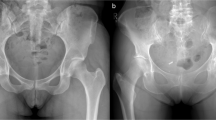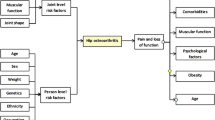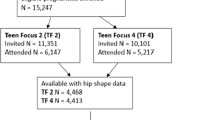Abstract
Purpose of review
This narrative review summarizes the evidence relating hip shape and risk of osteoarthritis at the hip, with a focus on the most recent body of work.
Recent findings
Hip osteoarthritis (OA) is a prevalent and potentially disabling condition with few effective non-surgical treatment options. Risk factors for hip OA appear to differ somewhat from those at other sites. Variations in hip morphology, whether assessed through standard geometric measures or statistical modeling methods, seem to increase hip OA risk and may provide a novel approach to interventions to reduce or prevent OA. Such variations have also led to focused surgical interventions to “correct” abnormal shape, although comparisons with non-surgical management are lacking.
Summary
There remains a lack of understanding regarding the optimal management, whether surgical, non-surgical, or a combination, for FAI syndrome. Even less is known regarding other potential morphologic variations that may contribute to OA risk. Additionally, many individuals who have shape variations that would seem to increase their risk will never develop hip OA. Questions remain regarding key risk factors for hip OA development, which individuals should be targeted for therapies, whether directed at symptoms, function, or prevention, and which therapies should be studied and offered. Trials are underway to help address some of these questions.
Similar content being viewed by others
References and Recommended Reading
Papers of particular interest, published recently, have been highlighted as: • Of importance •• Of major importance
Hootman JM, Helmick CG, Barbour KE, Theis KA, Boring MA. Updated projected prevalence of self-reported doctor-diagnosed arthritis and arthritis-attributable activity limitation among US adults, 2015–2040. Arthritis Rheumatol. 2016;68(7):1582–7.
Jafarzadeh SR, Felson DT. Updated estimates suggest a much higher prevalence of arthritis in US adults than previous ones. Arthritis Rheumatol. 2018;70(2):185–92.
Katz JN. Prevalence of arthritis revisited. Arthritis Rheumatol. 2018;70(2):153–4.
Kurtz SM, Ong KL, Lau E, Bozic KJ. Impact of the economic downturn on total joint replacement demand in the United States: updated projections to 2021. J Bone Joint Surg Am. 2014;96(8):624–30.
Kurtz S, Ong K, Lau E, Mowat F, Halpern M. Projections of primary and revision hip and knee arthroplasty in the United States from 2005 to 2030. J Bone Joint Surg Am. 2007;89(4):780–5.
Pereira D, Peleteiro B, Araujo J, Branco J, Santos RA, Ramos E. The effect of osteoarthritis definition on prevalence and incidence estimates: a systematic review. Osteoarthr Cartil. 2011;19(11):1270–85.
Kim C, Linsenmeyer KD, Vlad SC, Guermazi A, Clancy MM, Niu J, et al. Prevalence of radiographic and symptomatic hip osteoarthritis in an urban United States community: the Framingham osteoarthritis study. Arthritis Rheumatol. 2014;66(11):3013–7.
Jordan JM, Helmick CG, Renner JB, Luta G, Dragomir AD, Woodard J, et al. Prevalence of hip symptoms and radiographic and symptomatic hip osteoarthritis in African Americans and Caucasians: the Johnston County Osteoarthritis Project. J Rheumatol. 2009;36(4):809–15.
Murphy LB, Helmick CG, Schwartz TA, Renner JB, Tudor G, Koch GG, et al. One in four people may develop symptomatic hip osteoarthritis in his or her lifetime. Osteoarthr Cartil. 2010;18(11):1372–9.
Nelson AE, Allen KD, Golightly YM, Goode AP, Jordan JM. A systematic review of recommendations and guidelines for the management of osteoarthritis: the chronic osteoarthritis management initiative of the U.S. bone and joint initiative. Semin Arthritis Rheum. 2014;43(6):701–12.
• Meneses SR, Goode AP, Nelson AE, Lin J, Jordan JM, Allen KD, et al. Clinical algorithms to aid osteoarthritis guideline dissemination. Osteoarthr Cartil. 2016;24(9):1487–99. This overview of current OA management guidelines from a number of different expert organizations also provides more practical treatment algorithms for clinical use.
Gandhi R, Perruccio AV, Mahomed NN. Surgical management of hip osteoarthritis. CMAJ. 2014;186(5):347–55.
•• Nepple JJ, Clohisy JC. Evolution of Femoroacetabular Impingement Treatment: The ANCHOR Experience. Am J Orthop (Belle Mead NJ). 2017;46(1):28–34. This group, including the leaders in the area, summarizes the current state and data regarding FAI surgical interventions.
Collins JA, Ward JP, Youm T. Is prophylactic surgery for femoroacetabular impingement indicated? A systematic review. Am J Sports Med. 2014;42(12):3009–15.
Mahomed NN, Barrett JA, Katz JN, Phillips CB, Losina E, Lew RA, et al. Rates and outcomes of primary and revision total hip replacement in the United States medicare population. J Bone Joint Surg Am. 2003;85-A(1):27–32.
Daigle ME, Weinstein AM, Katz JN, Losina E. The cost-effectiveness of total joint arthroplasty: a systematic review of published literature. Best Pract Res Clin Rheumatol. 2012;26(5):649–58.
Larson CM, Clohisy JC, Beaule PE, Kelly BT, Giveans MR, Stone RM, et al. Intraoperative and early postoperative complications after hip arthroscopic surgery: a prospective multicenter trial utilizing a validated grading scheme. Am J Sports Med. 2016;44(9):2292–8.
Sink EL, Beaule PE, Sucato D, Kim YJ, Millis MB, Dayton M, et al. Multicenter study of complications following surgical dislocation of the hip. J Bone Joint Surg Am. 2011;93(12):1132–6.
Shearer DW, Kramer J, Bozic KJ, Feeley BT. Is hip arthroscopy cost-effective for femoroacetabular impingement? Clin Orthop Relat Res. 2012;470(4):1079–89.
de Sa D, Horner NS, MacDonald A, Simunovic N, Slobogean G, Philippon MJ, et al. Evaluating healthcare resource utilization and outcomes for surgical hip dislocation and hip arthroscopy for femoroacetabular impingement. Knee Surg Sports Traumatol Arthrosc. 2016;24(12):3943–54.
Egger AC, Frangiamore S, Rosneck J. Femoroacetabular impingement: a review. Sports Med Arthrosc Rev. 2016;24(4):e53–8.
Agricola R, Waarsing JH, Arden NK, Carr AJ, Bierma-Zeinstra SM, Thomas GE, et al. Cam impingement of the hip: a risk factor for hip osteoarthritis. Nat Rev Rheumatol. 2013;9(10):630–4.
•• Fairley J, Wang Y, Teichtahl AJ, Seneviwickrama M, Wluka AE, Brady SRE, et al. Management options for femoroacetabular impingement: a systematic review of symptom and structural outcomes. Osteoarthritis Cartilage. 2016;24(10):1682–96. This systematic review summarizes all the available data regarding FAI management through 2016.
•• Griffin DR, Dickenson EJ, O'Donnell J, Agricola R, Awan T, Beck M, et al. The Warwick Agreement on femoroacetabular impingement syndrome (FAI syndrome): an international consensus statement. Br J Sports Med. 2016;50(19):1169–76. This paper describes a consensus meeting and agreement regarding definitions of FAI syndrome, imaging findings, and current treatment options.
• Raveendran R, Stiller JL, Alvarez C, Renner JB, Schwartz TA, Arden NK, et al. Population-based prevalence of multiple radiographically-defined hip morphologies: the Johnston County Osteoarthritis Project. Osteoarthritis Cartilage. 2018;26(1):54–61. This recent paper from our group describes the frequency of radiographic cam and pincer morphologies in a population-based US cohort.
Laborie LB, Lehmann TG, Engesaeter IO, Eastwood DM, Engesaeter LB, Rosendahl K. Prevalence of radiographic findings thought to be associated with femoroacetabular impingement in a population-based cohort of 2081 healthy young adults. Radiology. 2011;260(2):494–502.
Nelson AE, Stiller JL, Shi XA, Leyland KM, Renner JB, Schwartz TA, et al. Measures of hip morphology are related to development of worsening radiographic hip osteoarthritis over 6 to 13 year follow-up: the Johnston County Osteoarthritis Project. Osteoarthr Cartil. 2016;24(3):443–50.
Nicholls AS, Kiran A, Pollard TC, Hart DJ, Arden CP, Spector T, et al. The association between hip morphology parameters and nineteen-year risk of end-stage osteoarthritis of the hip: a nested case-control study. Arthritis Rheum. 2011;63(11):3392–400.
Agricola R, Heijboer MP, Bierma-Zeinstra SM, Verhaar JA, Weinans H, Waarsing JH. Cam impingement causes osteoarthritis of the hip: a nationwide prospective cohort study (CHECK). Ann Rheum Dis. 2013;72(6):918–23.
Agricola R, Heijboer MP, Roze RH, Reijman M, Bierma-Zeinstra SM, Verhaar JA, et al. Pincer deformity does not lead to osteoarthritis of the hip whereas acetabular dysplasia does: acetabular coverage and development of osteoarthritis in a nationwide prospective cohort study (CHECK). Osteoarthr Cartil. 2013;21(10):1514–21.
Gregory JS, Waarsing JH, Day J, Pols HA, Reijman M, Weinans H, et al. Early identification of radiographic osteoarthritis of the hip using an active shape model to quantify changes in bone morphometric features: can hip shape tell us anything about the progression of osteoarthritis? Arthritis Rheum. 2007;56(11):3634–43.
Nelson AE, Liu F, Lynch JA, Renner JB, Schwartz TA, Lane NE, et al. Association of incident symptomatic hip osteoarthritis with differences in hip shape by active shape modeling: the Johnston County osteoarthritis project. Arthritis Care Res (Hoboken). 2014;66(1):74–81.
Lynch JA, Parimi N, Chaganti RK, Nevitt MC, Lane NE. The association of proximal femoral shape and incident radiographic hip OA in elderly women. Osteoarthr Cartil. 2009;17(10):1313–8.
Agricola R, Reijman M, Bierma-Zeinstra SM, Verhaar JA, Weinans H, Waarsing JH. Total hip replacement but not clinical osteoarthritis can be predicted by the shape of the hip: a prospective cohort study (CHECK). Osteoarthr Cartil. 2013;21(4):559–64.
Agricola R, Leyland KM, Bierma-Zeinstra SM, Thomas GE, Emans PJ, Spector TD, et al. Validation of statistical shape modelling to predict hip osteoarthritis in females: data from two prospective cohort studies (cohort hip and cohort knee and Chingford). Rheumatology (Oxford). 2015;54(11):2033–41.
Faber BG, Baird D, Gregson CL, Gregory JS, Barr RJ, Aspden RM, et al. DXA-derived hip shape is related to osteoarthritis: findings from in the MrOS cohort. Osteoarthr Cartil. 2017;25(12):2031–8.
Ahedi HG, Aspden RM, Blizzard LC, Saunders FR, Cicuttini FM, Aitken DA, et al. Hip shape as a predictor of osteoarthritis progression in a prospective population cohort. Arthritis Care Res (Hoboken). 2017;69(10):1566–73.
Castano-Betancourt MC, Van Meurs JB, Bierma-Zeinstra S, Rivadeneira F, Hofman A, Weinans H, et al. The contribution of hip geometry to the prediction of hip osteoarthritis. Osteoarthr Cartil. 2013;21(10):1530–6.
Boissonneault A, Lynch JA, Wise BL, Segal NA, Gross KD, Murray DW, et al. Association of hip and pelvic geometry with tibiofemoral osteoarthritis: multicenter osteoarthritis study (MOST). Osteoarthr Cartil. 2014;22(8):1129–35.
Nelson AE, Golightly YM, Liu F, Lynch JA, Gregory JS, Aspden RM, et al. Variations in hip shape are associated with prevalent radiographic knee OA: the Johnston County Osteoarthritis Project. Osteoarthr Cartil. 2014;22(Supp):S239–40.
An H, Marron JS, Schwartz TA, Renner JB, Liu F, Lynch JA, et al. Novel statistical methodology reveals that hip shape is associated with incident radiographic hip osteoarthritis among African American women. Osteoarthr Cartil. 2016;24(4):640–6.
Lindner C, Thiagarajah S, Wilkinson JM, arc OC, Wallis GA, Cootes TF. Development of a fully automatic shape model matching (FASMM) system to derive statistical shape models from radiographs: application to the accurate capture and global representation of proximal femur shape. Osteoarthr Cartil. 2013;21(10):1537–44.
Muthuri SG, Saunders FR, Hardy RJ, Pavlova AV, Martin KR, Gregory JS, et al. Associations between body mass index across adult life and hip shapes at age 60 to 64: evidence from the 1946 British birth cohort. Bone. 2017;105:115–21.
Kopec JA, Cibere J, Li LC, Zhang C, Barber M, Qian H, et al. Relationship between physical activity and hip pain in persons with and without cam or pincer morphology: a population-based case-control study. Osteoarthr Cartil. 2017;25(7):1055–61.
Lindner C, Thiagarajah S, Wilkinson JM, Panoutsopoulou K, Day-Williams AG, Cootes TF, et al. Investigation of association between hip osteoarthritis susceptibility loci and radiographic proximal femur shape. Arthritis Rheumatol. 2015;67(8):2076–84.
Baker-Lepain JC, Lynch JA, Parimi N, McCulloch CE, Nevitt MC, Corr M, et al. Variant alleles of the Wnt antagonist FRZB are determinants of hip shape and modify the relationship between hip shape and osteoarthritis. Arthritis Rheum. 2012;64(5):1457–65.
Waarsing JH, Kloppenburg M, Slagboom PE, Kroon HM, Houwing-Duistermaat JJ, Weinans H, et al. Osteoarthritis susceptibility genes influence the association between hip morphology and osteoarthritis. Arthritis Rheum. 2011;63(5):1349–54.
Mosler AB, Crossley KM, Waarsing JH, Jomaah N, Weir A, Holmich P, et al. Ethnic differences in bony hip morphology in a cohort of 445 professional male soccer players. Am J Sports Med. 2016;44(11):2967–74.
Nelson AE, Braga L, Renner JB, Atashili J, Woodard J, Hochberg MC, et al. Characterization of individual radiographic features of hip osteoarthritis in African American and White women and men: the Johnston County Osteoarthritis Project. Arthritis Care Res (Hoboken). 2010;62(2):190–7.
Katz JN, Brophy RH, Chaisson CE, de Chaves L, Cole BJ, Dahm DL, et al. Surgery versus physical therapy for a meniscal tear and osteoarthritis. N Engl J Med. 2013;368(18):1675–84.
Moseley JB, O'Malley K, Petersen NJ, Menke TJ, Brody BA, Kuykendall DH, et al. A controlled trial of arthroscopic surgery for osteoarthritis of the knee. N Engl J Med. 2002;347(2):81–8.
Frobell RB, Roos HP, Roos EM, Roemer FW, Ranstam J, Lohmander LS. Treatment for acute anterior cruciate ligament tear: five year outcome of randomised trial. BMJ. 2013;346:f232.
•• Wall PD, Fernandez M, Griffin DR, Foster NE. Nonoperative treatment for femoroacetabular impingement: a systematic review of the literature. PM R. 2013;5(5):418–26. This review remains the most comprehensive summary of non-operative FAI management.
Wyles CC, Norambuena GA, Howe BM, Larson DR, Levy BA, Yuan BJ, et al. Cam deformities and limited hip range of motion are associated with early osteoarthritic changes in adolescent athletes: a prospective matched cohort study. Am J Sports Med. 2017;45(13):3036–43.
Agricola R, Heijboer MP, Ginai AZ, Roels P, Zadpoor AA, Verhaar JA, et al. A cam deformity is gradually acquired during skeletal maturation in adolescent and young male soccer players: a prospective study with minimum 2-year follow-up. Am J Sports Med. 2014;42(4):798–806.
Roels P, Agricola R, Oei EH, Weinans H, Campoli G, Zadpoor AA. Mechanical factors explain development of cam-type deformity. Osteoarthr Cartil. 2014;22(12):2074–82.
Author information
Authors and Affiliations
Corresponding author
Ethics declarations
Conflict of Interest
Amanda E. Nelson reports grants from NIAMS K23AR061406 and the CDC, during the conduct of the study, and personal fees from GSK and from Health Press Ltd., outside the submitted work.
Human and Animal Rights and Informed Consent
This article does not contain any studies with human or animal subjects performed by any of the authors.
Additional information
This article is part of the Topical Collection on Osteoarthritis
Rights and permissions
About this article
Cite this article
Nelson, A.E. The Importance of Hip Shape in Predicting Hip Osteoarthritis. Curr Treat Options in Rheum 4, 214–222 (2018). https://doi.org/10.1007/s40674-018-0096-0
Published:
Issue Date:
DOI: https://doi.org/10.1007/s40674-018-0096-0




